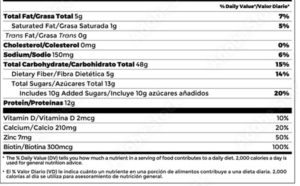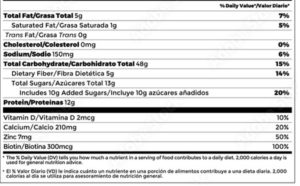Understanding food labels can often be tricky and most people don’t know where to begin! With consumers wanting to know more about their food, it is important to know how to accurately and effectively interpret a food label to make an informed decision and eat a healthy diet.
The first rule when shopping is to be wary of the claims made on the packaging. The front labels present on packaging often display misleading or false information which don’t help inform your purchase. For example, many high sugar juices promise you 100% concentrate, but what this really means is all the water in the juice is removed out and often additives are included such as sweeteners like high-fructose corn syrup.
Some research shows health claims on the front of labels make people believe the product is healthier than a product without such claims. For example, some breakfast cereals are labeled as “whole-grain” despite having a high sugar content. With such false claims and not being able to thoroughly inspect the ingredients list can make it increasingly difficult for consumers to choose a healthy option.
Next, we look at the back label on the box. This can be overly crowded and often overwhelming with a lot of unknown jargon so let’s break it down.
1. Serving Information
The serving information can be helpful to understand the amount of the food item that most people consume- not how much you should consume. The serving size is often reported in cups or grams. It can be used as a reference of how much of the food item you would intake in one meal and determine the calories and nutrients you are receiving in that specific amount.

2. Calories
Calories are a measure of energy that the food you eat provides you with. For example, in this label, one serving (⅔ cup) provides you with approximately 230 calories. Consuming a surplus of calories a day can lead to weight gain. It is recommended that to maintain a healthy body weight the amount of calories consumed a day should also be equivalent to the amount burned by your body. For an average adult in the US, recommended daily caloric intake is around 2,000 calories per day, however this varies based on age, sex, height, weight and the amount of physical activity you partake in.

3. Nutrients

Some key nutrients found on every food label include total fat, cholesterol, sodium, total carbohydrates, protein, vitamins and minerals. In general, you want to consume items with a high nutritional value such as monounsaturated fats, fiber, proteins, vitamins and minerals as they are beneficial for lowering blood glucose, aiding bowel movements, and reducing the risk of developing various diseases. You want to consume less of the saturated fats, sodium and added sugars.
Saturated and trans fats and sodium are associated with a higher incidence of cardiovascular disease and high blood pressure leading to poor health outcomes, hence they should be limited. Added sugars on the other hand, are one of the most overlooked culprits of disease and are imperative to avoid.

So what are added sugars?
Total sugars refer to the natural sugars found in food and beverages, for example the sugar you would naturally find in fruit and milk. Added sugars however, are the additional sugars added to foods and beverages during their processing. These include sucrose, sweeteners such as table sugar, sugars from syrups, honey, or juices. These added sugars can quickly add up and lead to a higher daily caloric intake. As a result, less nutrients are obtained from other foods while staying within the caloric limit of the day.
Be sure to check if the total sugars amount listed includes the added sugars, or if it is listed separately.
4. The Percent Daily Value (%DV)
Percent daily value refers to the amount of nutrients obtained in one serving of food that contribute to your daily recommended dietary intake. For example, a Vitamin D percent daily value of 10% means one serving of the food item will provide you with 10% of the Vitamin D you need for that day.

Percent Daily Value can be used as a guide to gauge whether a food may be high or low in a nutrient. For example, a Percent DV of 5% means that food item will provide you with a lower amount of that nutrient that you need for the day, while a value of 20% or higher will provide you with a higher amount of that nutrient required for the day. Keeping this in mind, you want to choose foods that are higher in % DV of fibers, and vitamins and minerals, and lower in % DV of added sugars, sodium, and saturated fats.
Keep these tips in mind on your next trip to the grocery store!
References:
https://www.fda.gov/food/new-nutrition-facts-label/how-understand-and-use-nutrition-facts-label
https://www.healthline.com/nutrition/how-to-read-food-labels



